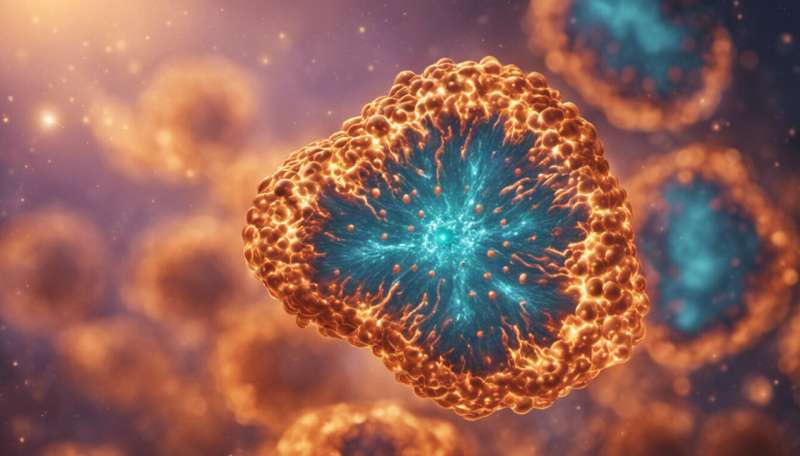Glowing abdomens reveal enzyme activity

Professor Jean-Christophe Leroux and his colleagues have developed a method with which they can observe gluten-splitting enzymes in a living organism. This is an important step towards developing effective digestive proteins that can be used against coeliac disease.
A coeliac disease sufferer displays a chronic oversensitivity reaction to gluten and its degradation products, which trigger strong immune responses after absorption from the gastrointestinal tract. This protein is contained in several types of cereal, including wheat, barley and rye. Without gluten proteins, the dough properties are not ideal to produce bread and pastries. All kinds of foods, some of which contain only traces of wheat or other cereals, are out of bounds to sufferers. Coeliac disease affects up to one percent of the population in Western countries.
The disease is caused by a faulty gene, with environmental influences or certain childhood infections also thought to play a part in causing the illness.
Although coeliac disease is not fatal, it makes life more difficult and is harmful in the long term: gluten triggers an auto-immune response that also affects the intestine in particular and can lead to digestive upsets, severe diarrhoea or weight loss. Coeliac patients have a greater risk of suffering from osteoporosis or cancer. In addition, there are numerous other secondary diseases attributable to gluten intolerance.
A wheat-free diet is the only answer
There is currently only one way of alleviating the consequences: a change of diet and complete avoidance of products containing gluten. So far there is no medical treatment method, but Jean-Christophe Leroux, Professor of Pharmaceutical Sciences at ETH Zurich, has now found a starting point more or less by chance: a polymer that binds gluten, thus suppressing its toxicity. The polymer-gluten complex passes through the intestine undigested and is excreted. Experiments in mice have shown great promise in this respect.
Another treatment idea is to administer digestive enzymes orally to coeliac patients. These enzymes split the gluten, thus detoxifying it. This method was developed by Professor Chaitan Khosla of Stanford University in the USA. This kind of administration of digestive enzymes is already been applied successfully in other diseases such as deficient pancreas function or lactose intolerance. However, because enzymes are proteins, they are destroyed or inactivated in the gastrointestinal tract. So Leroux wanted to know first of all how much of the enzyme needs to be administered and in what form in order to eliminate gluten completely.
Active enzyme makes the abdomen glow
To this end, the ETH Zurich Professor and his doctoral student Gregor Fuhrmann have now for the first time developed a method with which they can track the efficiency and effectiveness of enzymes known as proline-specific endopeptidases (PEPs) in the gastrointestinal tract of a living organism. They did this by creating a short model protein containing the segment of gluten that causes the disease, to which they coupled a “muting” molecule and a fluorescent dye. The researchers administered this molecule to rats, after which they fed the animals two PEPs, one from the bacterium Myxococcus xanthus and one from Flavobacterium meningosepticum. As soon as an enzyme had broken open the modified gluten protein, the dye was activated. The complex started to fluoresce with an intensity that varied depending on the PEP activity. By using a suitable imaging method, the researchers were eventually able to monitor in real time the activity of the enzymes. The brighter the fluorescence and the longer it persisted, the more effective the enzyme was.
Although both enzymes were active in the small intestine, where the medium is alkaline, only the Flavobacterium enzyme was active in the stomach. However, the researchers were able to increase the activity of the Myxococcus enzyme in the acidic stomach by administering an additional acid blocker that neutralised the stomach acid.
The first monitoring tool
The two ETH Zurich researchers presented this method in the scientific journal PNAS. Leroux explains that, “This is the first tool to observe these enzymatic processes in the digestive tract of a living organism.” He says that, although there are already many methods to test enzyme activity in the test tube, it is not possible to replicate the gastrointestinal tract realistically in vitro. This is why the results obtained with them are only of minor significance. The new method yields information about the activity of the enzymes in the gastrointestinal tract. He says that this could help to improve their therapeutic efficacy.
The next steps in the struggle against coeliac disease should see the scientists attaching polymers to the digestive enzymes being used, to protect them from premature degradation in the stomach. Another possibility would be to package the enzymes in transport containers that are not released until they reach the alkaline medium of the intestine.
More information: Fuhrmann G & Leroux J-C: In vivo fluorescence imaging of exogenous enzyme activity in the gastrointestinal tract. 2011. PNAS 108:9032-9037. DOI:10.1073/pnas.1100285108
















